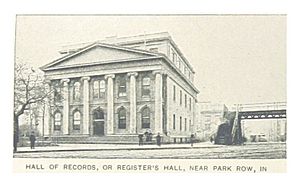City Hall Park facts for kids
Quick facts for kids City Hall Park |
|
|---|---|

The park in 2007
|
|
| Type | Public park |
| Nearest city | New York City, New York, United States |
City Hall Park is a public park in Manhattan, New York City. It surrounds New York City Hall in an area called the Civic Center. This park was once the main common land for the early city of New York.
Contents
History of City Hall Park
Early Days: 17th Century
In the 1600s, a man named David Provoost was an important officer. He worked for the Dutch West India Company. In 1652, he was one of nine men who helped govern New Amsterdam. This was the old name for New York City.
David Provoost was a good leader. He even commanded a fort in Connecticut for a time. He also became the first sheriff of Breucklyn, which is now Brooklyn. Provoost owned about 35 acres of land. This land included the area where City Hall Park is located today.
Protests and Patriotism: 18th Century
Before and during the American Revolutionary War, City Hall Park was a busy place. Many important meetings and protests happened here. For example, in 1765, people in New York protested the Stamp Act. This was a new tax from the British government.
On March 18, 1766, New Yorkers celebrated. The Stamp Act was removed, and everyone was very happy.
In 1766, a group called the Sons of Liberty put up the first "Liberty pole". This was a tall pole with the word "liberty" on top. British soldiers kept cutting it down. But the Sons of Liberty put up a new one five times! Today, a copy of the pole stands near its original spot. It is between City Hall and Broadway.
In 1766, St. Paul's Chapel was finished. It was a chapel for Trinity Church. It was built a bit away from the main city. Two years later, a new jail called the Bridewell was started. During the Revolutionary War, American prisoners were held in this jail.
A very important event happened on July 9, 1776. People gathered in the park to hear the United States Declaration of Independence read aloud. George Washington himself read it. On November 9, 1783, American forces took back the Civic Center. George Washington raised the American flag in the park. Six years later, Washington became the first president of the United States. After his inauguration, he visited St. Paul's Chapel. It is the oldest church still standing in Manhattan.
Growth and Change: 19th Century
By 1802, the original City Hall was old and too small. New York City decided to build a new one. They held a competition to find the best design. The new City Hall was finished in 1812. It was designed in a style called Federal architecture, with some French influences. Some people thought the new building was too far north. But others liked its location and beautiful look.
New York City's culture was growing. In 1818, The Rotunda was built. It was the city's first art museum.
Slavery was ended in New York on July 4, 1827. This day was called Emancipation Day. People celebrated for two days in the park with a big parade.
In 1830, an old jail for people who owed money was changed. It became the city's hall of records. This building was torn down in 1903. It was the oldest city building in New York at that time.
New York City's beautiful buildings and growing economy attracted visitors. In 1836, the city's first luxury hotel was built. It was called the Astor House.
In 1842, the Croton Fountain was placed in the park's center. This celebrated the Croton Aqueduct. This aqueduct brought clean water to New York City for the first time. It brought water from the Croton Dam, over 40 miles (64 km) north. It was a huge engineering success for the 1800s.
Starting in 1861, the Tweed Courthouse was built in the northern part of the park. This courthouse became a symbol of corruption. It was built with money from a very powerful politician named William M. Tweed. His political group, Tammany Hall, controlled the city and state governments. The courthouse was finished in 1881, twenty years after it started.
Images for kids
See also
 In Spanish: City Hall Park para niños
In Spanish: City Hall Park para niños





